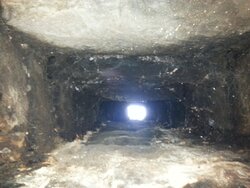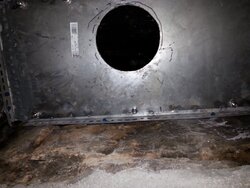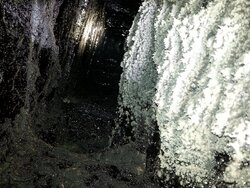- Hi, everyone. Newbie on the forums here and a 'shocked' newbie when it comes to creosote. Scanned through the threads and didn't see this topic.
- We've bought an old homestead with a limestone chimney circa 1908 or so. No damper was ever in place.
- One important note here: opposite the back wall of the living room "fire box" is the bedroom with another fireplace mirroring the living room. That wall separates the two fireboxes and tapers off to a shared chimney exiting through attic and (fortunately) steel roof.
- Pic 1 [original.jpg] is its 'clean and pristine' condition prior to us moving in and installing a small Buck stove into the living room fireplace. The bedroom fireplace is sealed up with plywood and aluminum tape. Looks awful but is only temporary. The Buck produces heat well, burns seemingly well and circulates that heat very well in the living space. We've burned probably 2 cords since November of seasoned oak, maple, hickory and ash. Seasoned as in tops remaining from logging operation in 2012 that I've cut up and split since fall. (Still need to buy a moisture meter to determine HOW seasoned, right?)
- Pic 2 [plate.jpg] is a steel plate I installed about smoke ledge height inside the chimney; used a hammer drill and TapCons into the limestone blocks, then boiler mastic to seal the edges well. A 18" piece of black pipe (with round damper installed just above the stove ) runs from the top of the stove through the plate and extends about 6" above the plate into the chimney. The chimney has another plate and cap mounted on the top.
- I've noticed more and more that far too much smoke enters the living room when I open the door, even with good fire and what should be good draft. (Damper full open) A very fine layer of dust/ash seems to cover everything in the house no matter how often we dust or vacuum. I've decided to install single wall black pipe top to bottom through that plate to improve the draft and hopefully get much more smoke/ash outside where it belongs.
- Today, I removed the stove and pulled down the short section of pipe from the lower plate. WOW! See pic 3 [now.jpg]. MAJOR stage 3 creosote from about 2' above pipe tip to the very top of chimney.
- So my questions: I still intend to install the 24 gauge 6" single wall black pipe running back through that lower plate and connect it to a cap at the top. No way can I afford a SS liner outside that and double-wall pipe is out as well. Should I be concerned at all with all that creosote? Can it ignite simply from radiant heat from the pipe inside the chimney? Your recommendations?
- Thanks to all in advance for your help and advice!
"Edens Garden" Eidson, TN
Attachments
Last edited:




